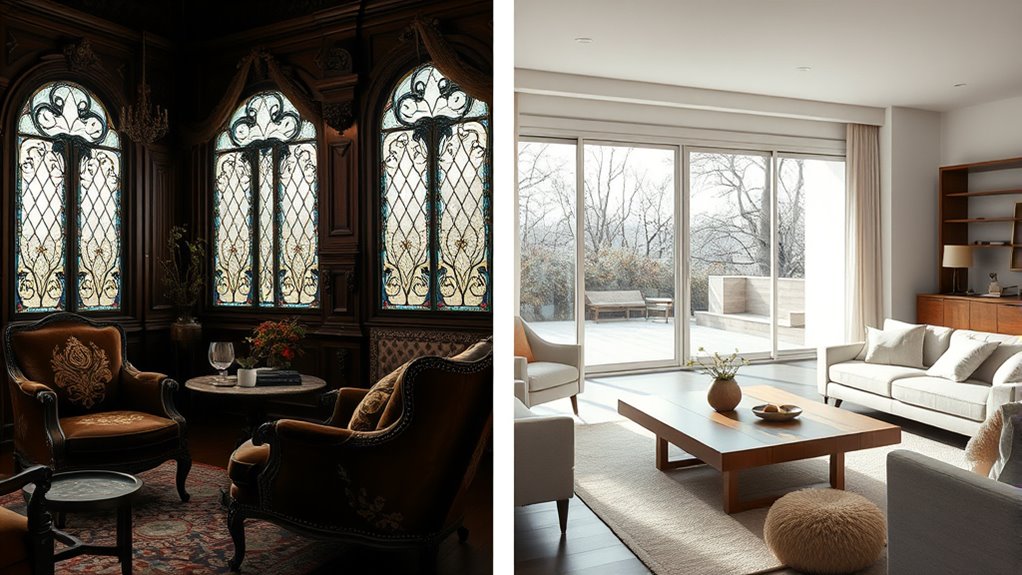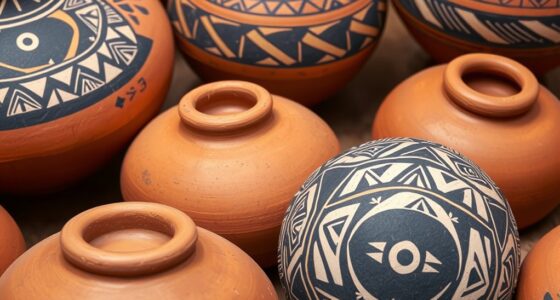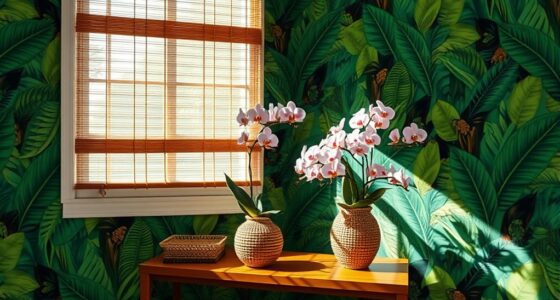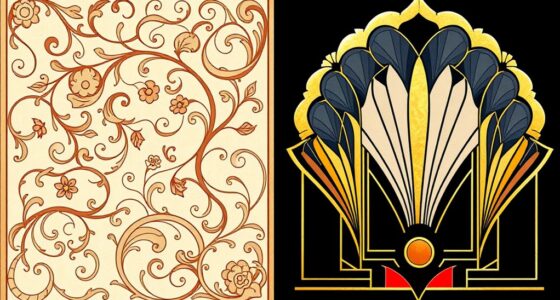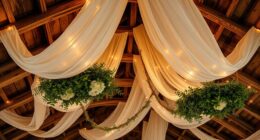Victorian interiors highlight ornate details, rich fabrics, and elaborate craftsmanship, reflecting a society that valued luxury and formal elegance. In contrast, Mid-century Modern spaces emphasize simplicity, sleek lines, and open layouts, showcasing modern materials and functional design. Victorian decor feels grand and detailed, while Mid-century Modern offers minimalism and practicality. If you want to see how these contrasting styles shape spaces and their legacies, there’s much more to discover ahead.
Key Takeaways
- Victorian interiors feature ornate details, heavy materials, and formal layouts, reflecting luxury and craftsmanship of the 19th century.
- Mid-century Modern interiors emphasize minimalism, open spaces, and sleek, lightweight materials, characteristic of post-WWII design.
- Victorian style showcases intricate ornamental patterns, floral motifs, and elaborate moldings, while Mid-century Modern favors geometric, simple forms.
- Victorian floor plans are symmetrical and formal, contrasting with the open, fluid layouts of Mid-century Modern spaces.
- The legacy of Victorian craftsmanship and ornamentation influences contemporary decorative motifs, while Mid-century Modern’s functional simplicity endures.
Origins and Historical Context of Victorian and Mid-Century Modern Styles
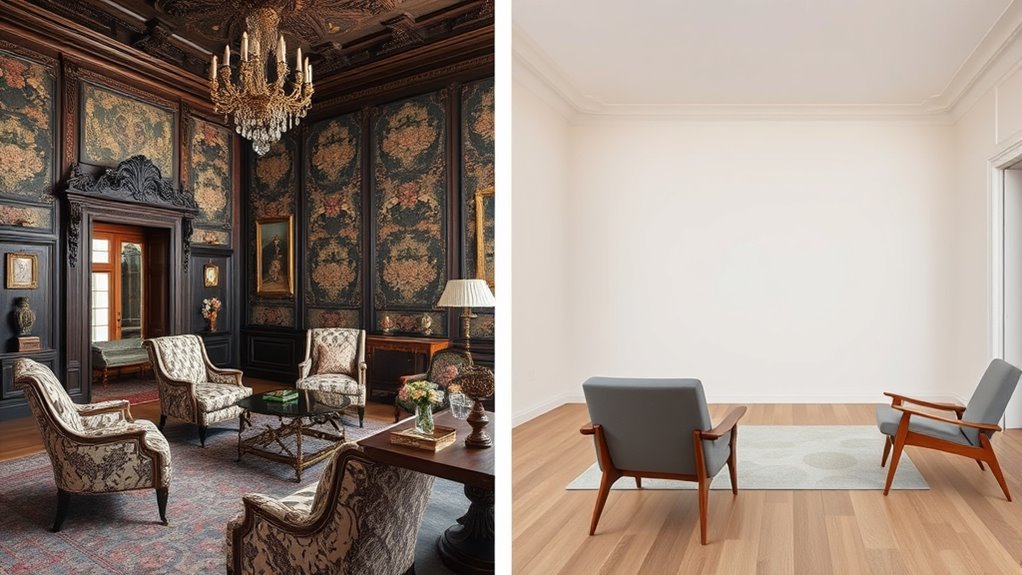
The Victorian and Mid-Century Modern styles each emerged during distinct periods, reflecting the social and cultural shifts of their times. Victorian craftsmanship emphasized elaborate detail, ornate patterns, and rich textures, showcasing a society focused on status and refinement. This style thrived during the reign of Queen Victoria, roughly from 1837 to 1901, and embodied a love for decorative complexity. In contrast, Mid-century Modern design arose after World War II, emphasizing simplicity and functionality through mid-century minimalism. It responded to the desire for practical, clutter-free living, favoring clean lines and open spaces. These styles reveal how architecture and interiors mirror the values and technological advancements of their respective eras, shaping the way homes and public spaces were designed. Incorporating natural materials and authentic craftsmanship can further deepen the connection to these historical styles.
Architectural Elements and Structural Design Features
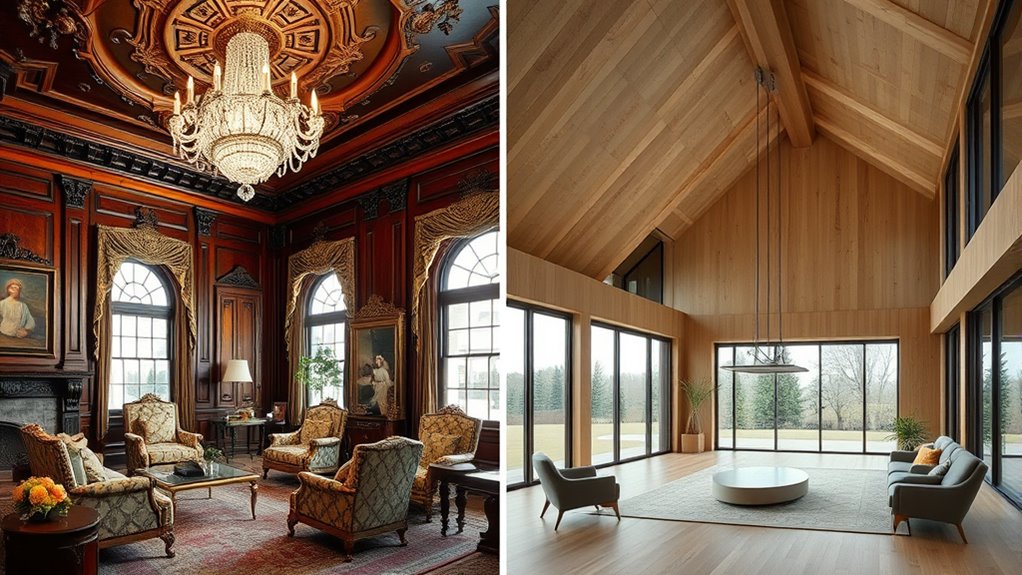
You’ll notice how ornamental detailing and ornamentation define the character of many historical interiors, adding visual interest and craftsmanship. The floor plans and spatial flow reveal how spaces were organized to serve social and functional needs of their time. Ultimately, examining the structural materials and techniques shows how builders balanced durability with aesthetic expression in their designs. Additionally, creative practice played a role in how artisans and designers approached the decorative elements, blending functionality with artistry.
Ornamental Detailing and Ornamentation
Have you ever noticed how ornamental detailing transforms a building from simple to spectacular? It’s all about the ornamental motifs and decorative carvings that add character and elegance. Victorian interiors often feature intricate patterns, floral designs, and elaborate borders that draw your eye to moldings, cornices, and ceiling medallions. These details highlight craftsmanship and give each space a sense of richness. In contrast, Mid-Century Modern interiors favor minimal ornamentation, focusing on clean lines and functional forms. When ornamentation appears, it’s subtle—perhaps a simple geometric motif or a sleek decorative element. By examining these details, you see how ornamentation reflects each era’s aesthetic priorities—Victorian’s lavishness versus Mid-Century Modern’s restrained elegance. Ornamentation isn’t just decoration; it’s a statement of style and cultural values. Additionally, understanding architectural ornamentation techniques provides insight into how artisans conveyed cultural identity and technological advances of their respective periods.
Floor Plans and Spatial Flow
Ever wonder how floor plans shape the way a space feels and functions? Victorian interiors often feature intricate layouts emphasizing ornamental symmetry, creating a balanced and formal atmosphere. Rooms are arranged to highlight a clear spatial hierarchy, with grand entryways leading to spacious, ornate parlors and private chambers. This design directs movement and emphasizes decorative elements, giving a sense of grandeur. In contrast, Mid-Century Modern layouts prioritize open floor plans that promote seamless spatial flow. Walls are minimized, fostering a sense of connection and freedom of movement. The focus shifts from ornamental symmetry to functional simplicity, encouraging a more relaxed and flexible environment. Your understanding of these spatial arrangements reveals how interior design influences your experience within each era’s distinctive aesthetic.
Structural Materials and Techniques
Structural materials and techniques are fundamental to shaping the durability, aesthetics, and overall integrity of interior spaces. During the Victorian era, structural innovations relied heavily on heavy masonry, ornate woodwork, and cast iron, emphasizing material durability and decorative detail. Mid-century modern design, however, prioritized clean lines and simplicity, utilizing innovative materials like steel, plywood, and reinforced concrete to achieve open, flexible interiors. These advances allowed for larger spans and reduced load-bearing walls, transforming interior layouts. You’ll notice how Victorian interiors showcase intricate craftsmanship and robust materials, while mid-century modern spaces emphasize lightweight, functional elements driven by modern structural innovations. Both styles reflect their respective eras’ approach to balancing structural integrity with visual appeal, shaping timeless interior environments. Additionally, the use of vetted materials ensured safety and longevity in both architectural styles.
Color Palettes and Material Choices in Each Style
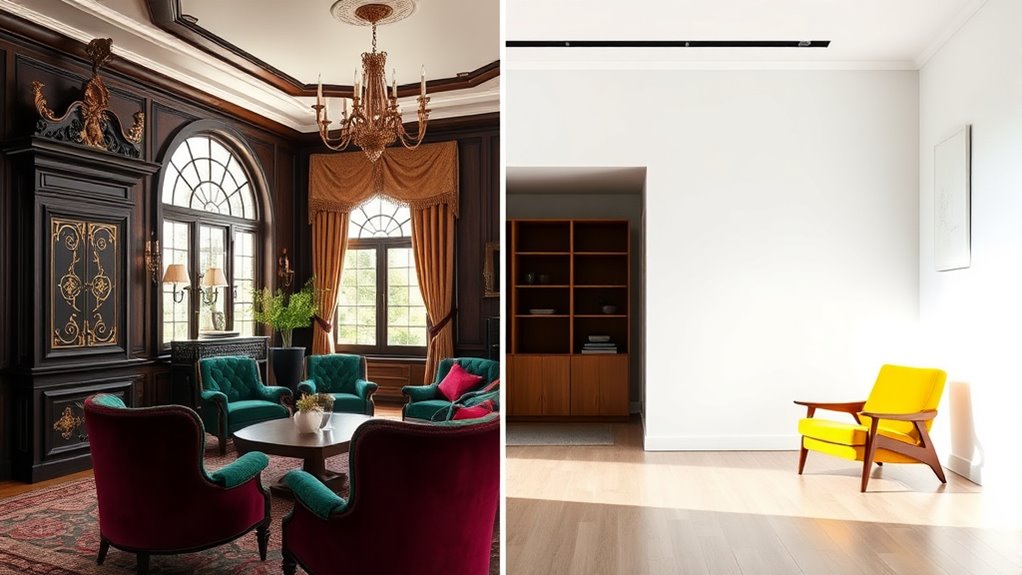
Each historical interior style features distinctive color palettes and material choices that define its character. Victorian interiors often showcase rich, deep color schemes like burgundy, emerald, and gold, creating a sense of opulence. You’ll notice luxurious material textures such as heavy velvets, intricately patterned wallpapers, and dark, polished woods. In contrast, Mid-Century Modern spaces favor lighter, more muted color schemes like soft pastels, warm earth tones, and clean neutrals. The material textures tend to be sleek and minimalist, with smooth plastics, light-colored woods, and fabrics like linen or cotton. These choices reflect each style’s core aesthetic—Victorian’s ornate richness versus Mid-Century Modern’s understated simplicity—shaping their unique visual identities and atmospheres. Additionally, understanding the material textures used in each era reveals how craftsmanship and available resources influenced their distinctive looks.
Furniture and Decor: Characteristics and Typical Pieces
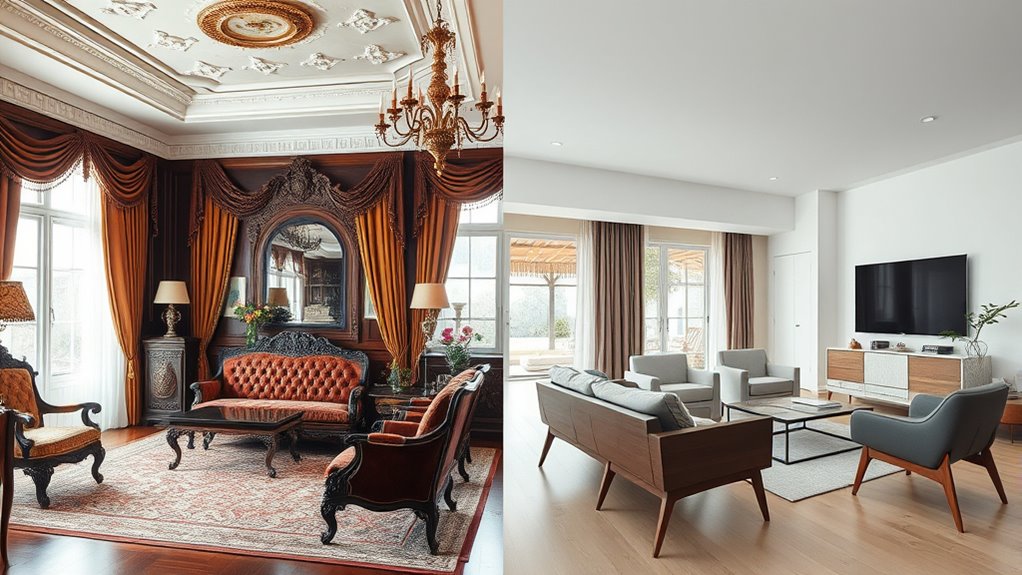
You’ll notice that furniture and decor from different periods feature distinct ornamentation and intricate detailing that reflect their era’s craftsmanship. Material and finish choices vary widely, from rich woods and gilded accents to painted surfaces, highlighting each style’s unique character. Recognizing signature pieces and styles helps you identify the period and appreciate the design’s historical significance. Additionally, understanding the Material and finish choices common to each era can further enhance your ability to distinguish between Victorian and Mid-Century Modern interiors.
Ornamentation and Detailing
Have you ever noticed how intricate carvings, gilded accents, and elaborate inlays define the character of historical furniture and decor? Ornamentation and detailing play a crucial role in reflecting each era’s aesthetic. Victorian pieces often feature ornate motifs, such as floral patterns, scrolls, and swirls, with decorative carvings that emphasize craftsmanship. Gilded accents add richness and grandeur, highlighting the opulence of the period. In contrast, Mid-Century Modern design favors minimal ornamentation, with clean lines and subtle detailing. Decorative carvings are rare, and ornamentation tends to be understated, focusing on form rather than embellishment. The difference lies in the elaborate, expressive ornamentation of Victorian styles versus the restrained, functional detailing of mid-century pieces. Additionally, the variety of materials used in each style further distinguishes their aesthetic, with Victorian furniture often incorporating rich woods and metals, while Mid-Century Modern employs lighter, more streamlined materials.
Material and Finish Choices
Material and finish choices define the overall appearance and durability of historical furniture and decor, often reflecting the technological advances and available resources of each era. Victorian pieces feature rich, dark woods like mahogany and oak, emphasizing material durability and elaborate ornamental motifs. Finishes such as lacquer and deep stains enhance their opulence, while intricate carvings highlight craftsmanship. In contrast, Mid-Century Modern furniture favors lighter woods like teak and walnut, with smooth, clean finishes that showcase natural grain. These choices prioritize simplicity and functionality, with less emphasis on ornamentation. The focus on material durability guarantees longevity, but the finishes are often minimalist, allowing the materials’ inherent beauty to stand out. Ultimately, these material and finish choices shape the distinct visual and tactile identities of each style. Additionally, material and finish choices can also influence the cybersecurity of furniture, especially as smart or connected devices become more integrated into interior design.
Signature Pieces and Styles
Signature pieces and styles define the visual identity of each historical interior, capturing the essence of their respective eras. Victorian interiors showcase ornate patterns and decorative motifs, with furniture featuring intricate carvings, curved lines, and opulent fabrics. Expect heavy, upholstered chairs, elaborate mirrors, and richly decorated cabinetry that emphasize luxury and craftsmanship. Mid-century modern style, by contrast, favors clean lines and minimal ornamentation, with signature pieces like sleek wooden sideboards, tapered legs, and geometric patterns. Decorative motifs are subtle, often reflected in textured surfaces or simple patterns. This style emphasizes functionality and simplicity, creating a balanced, timeless look. Recognizing these signature pieces helps you appreciate how each era’s unique characteristics shape the overall aesthetic of their interiors.
Atmosphere and Ambiance: Creating Mood and Space
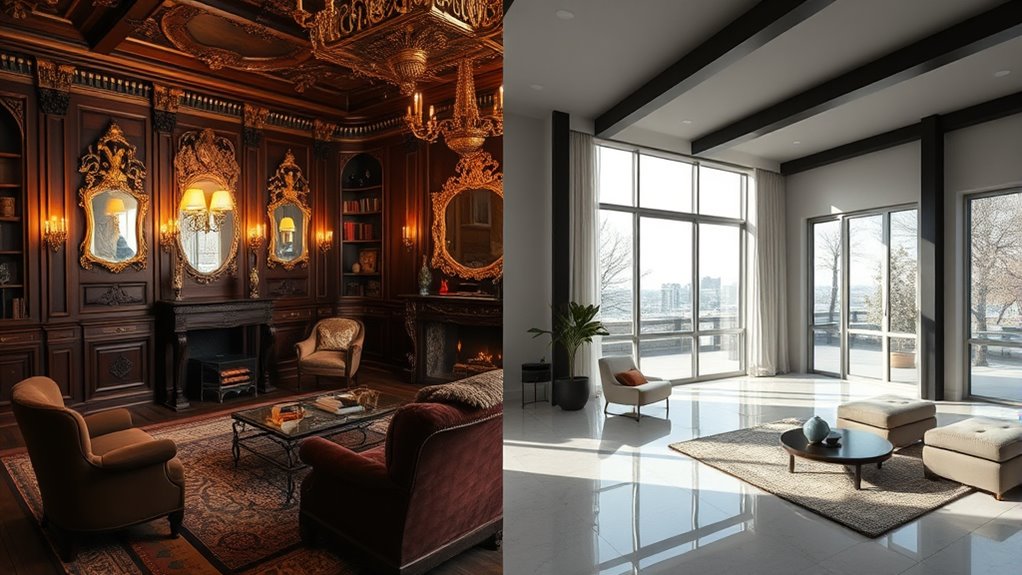
Creating the right atmosphere and ambiance in a historic interior involves carefully manipulating elements like lighting, color, and layout to evoke a specific mood and sense of space. Lighting techniques play a vital role, whether it’s soft, warm bulbs for Victorian elegance or sleek, recessed fixtures for Mid-Century Modern clarity. You should also consider acoustic treatments to manage sound quality, enhancing comfort and intimacy or openness, depending on your goal. Strategic placement of light sources and sound-absorbing materials can transform a space’s character, making it feel cozy, dramatic, or spacious. Additionally, understanding the importance of Lighting techniques can help you achieve the desired atmosphere effectively. By balancing these elements thoughtfully, you create a mood that aligns with the era’s style, inviting occupants to experience the space as it was meant to be felt.
Influence and Legacy in Contemporary Interior Design

The influence of historical interiors continues to shape contemporary interior design, inspiring the way spaces are conceived and decorated today. You’ll notice architectural symbolism embedded in modern designs, reflecting historical themes or cultural identities. Decorative motifs, such as intricate patterns from Victorian times or sleek forms from Mid-Century Modern, are often incorporated to evoke specific eras or moods. These elements serve as visual cues that connect past and present, giving spaces depth and meaning. By understanding how historical interiors used symbolism and motifs, you can create interiors that honor tradition while feeling fresh and relevant. Additionally, color accuracy in choosing palette schemes can enhance the authenticity of a historical style. This legacy encourages designers to blend old-world details with contemporary aesthetics, producing environments that are both meaningful and visually compelling.
Frequently Asked Questions
How Did Technological Advancements Influence Victorian and Mid-Century Modern Interiors?
Technological advancements, like the industrial revolution and mass production, greatly shaped Victorian and mid-century modern interiors. You see, Victorian interiors became more ornate as new machinery allowed for detailed woodwork and decorative elements. In contrast, mid-century modern designs embraced sleek lines and functional forms, thanks to innovations in materials like plywood and plastics. These advancements made stylish, practical interiors more accessible, transforming how you experience and decorate your living spaces.
What Cultural or Societal Factors Shaped Each Style’s Development?
You see that Victorian interiors reflect a society obsessed with social class and gender roles, emphasizing opulence and strict hierarchies. In contrast, mid-century modern designs emerged from a culture valuing simplicity, functionality, and gender equality, influenced by post-war optimism. These styles mirror societal shifts: Victorian grandeur showcases class distinctions, while mid-century modern’s clean lines embody a move toward egalitarianism and practicality.
Are There Regional Variations Within Victorian and Mid-Century Modern Designs?
Imagine each interior style as a river flowing through different lands. In Victorian design, regional influences bring stylistic diversity, with ornate details in England and bold patterns in America. Mid-century modern varies as well; Scandinavian simplicity contrasts with California’s vibrant hues. These regional influences shape unique adaptations, giving each style a local flavor that reflects the culture and environment, making each space a personal, cultural expression.
How Did Global Trade Impact Material Availability for These Styles?
Global trade, through established trade routes, markedly impacted material sourcing for Victorian and Mid-Century Modern styles. You’ll notice that Victorian interiors often feature imported woods, textiles, and decorative items, thanks to extensive trade networks. Similarly, Mid-Century Modern designers sourced innovative materials like plywood and fiberglass globally, expanding their palette. This access to diverse resources allowed these styles to evolve, reflecting a blend of local craftsmanship and international influence.
What Role Did Prominent Designers or Architects Play in Each Movement?
You see, prominent designers and architects considerably shaped each movement through interior innovation and artistic influence. Victorian designers emphasized ornate details and craftsmanship, shaping the opulent aesthetic, while Mid-Century Modern pioneers prioritized simplicity, functionality, and clean lines. Their bold ideas and unique visions influenced not just interiors but also broader cultural trends, inspiring others to adopt new styles that reflected evolving tastes and technological advancements.
Conclusion
By blending bold boundaries and beautiful details, Victorian and mid-century modern styles showcase striking symmetries and sleek simplicity. You can craft mesmerizing spaces that combine classic charm with contemporary cool, creating comfort and character. With a careful combination of color, craftsmanship, and creativity, you can transform your interiors into inviting, inspiring environments. Embrace the elegance of the past and the innovation of the present to design a dynamic, distinctive domain that truly reflects your personality.

